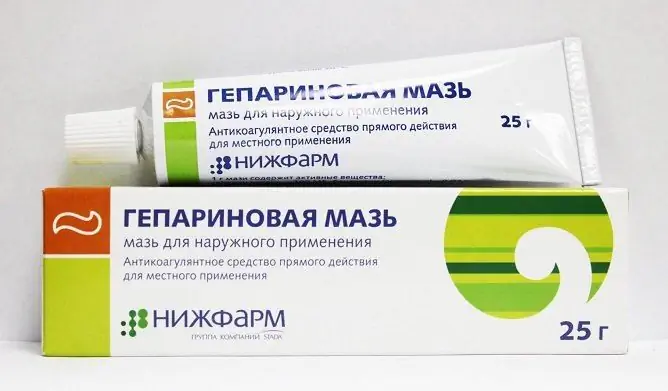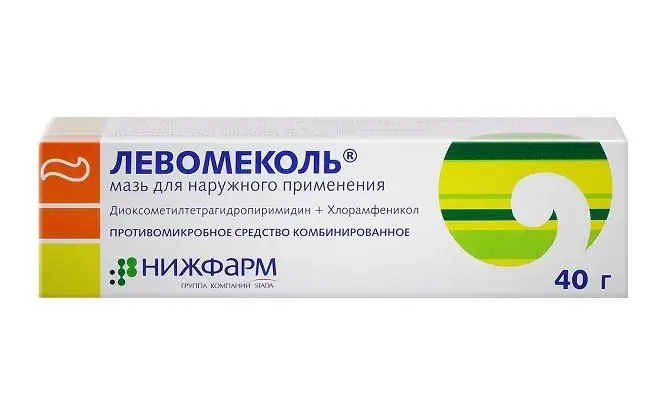- Author Rachel Wainwright [email protected].
- Public 2023-12-15 07:39.
- Last modified 2025-11-02 20:14.
Fusiderm
Fusiderm: instructions for use and reviews
- 1. Release form and composition
- 2. Pharmacological properties
- 3. Indications for use
- 4. Contraindications
- 5. Method of application and dosage
- 6. Side effects
- 7. Overdose
- 8. Special instructions
- 9. Application during pregnancy and lactation
- 10. Use in childhood
- 11. Drug interactions
- 12. Analogs
- 13. Terms and conditions of storage
- 14. Terms of dispensing from pharmacies
- 15. Reviews
- 16. Price in pharmacies
Latin name: Fusiderm
ATX code: D06AX01
Active ingredient: fusidic acid
Producer: Pharma International (Jordan), LEO Laboratories (Ireland), Biosynthesis, JSC (Russia)
Description and photo update: 2018-26-10

Fusiderm is an antibacterial agent for external use.
Release form and composition
Fusiderm is available in the following dosage forms:
- cream for external use 2%: white or white with a yellow tint;
- ointment: dense, translucent, white;
- gel: soft consistency, white.
All dosage forms are packaged in 15 g aluminum tubes, 1 tube in a cardboard box.
Composition of 1 g of cream:
- active substance: fusidic acid (fusidic acid) - 20 mg;
- additional components (depending on the manufacturer): liquid paraffin (vaseline oil), emulsifier No. 1, butylhydroxyanisole (E 320), medical white petrolatum, glycerol (distilled glycerin), polysorbate-80 (tween-80), potassium sorbate (E 202), purified water; or cetostearyl alcohol, white soft paraffin, polyethylene glycol cetostearyl ether, methylparaben (E 218), mineral oil, propylene glycol, sodium citrate, propylparaben (E 216), purified water.
Composition of 1 g of ointment:
- active substance: sodium fusidate - 20 mg;
- additional components: cetostearyl alcohol, white wax, white soft paraffin, mineral oil.
Composition of 1 g of gel:
- active substance: fusidic acid (fusidic acid) - 20 mg;
- additional components: methylparaben (E 218), isopropyl myristate, carbomer, polysorbate 20, triethanolamine, sodium edetate, purified water.
Pharmacological properties
Pharmacodynamics
Fusidic acid / sodium fusidate, the active substance of the drug, belongs to the group of fusidins - natural antibiotics, in which the mechanism of action is associated with a violation of protein production in the bacterial cell. By interfering with the elongation of factor G, they prevent it from binding with ribosomes and guanosine triphosphate (GTP), which leads to interruption of the release of energy consumed during synthesis.
The following microorganisms are sensitive to the active substance of Fuziderm:
- gram-positive bacteria - Corynebacterium minutissimum, Staphylococcus epidermidis (including methicillin-resistant strains), Staphylococcus aureus, Clostridium spp., Streptococcus pyogenes;
- gram-negative bacteria - Neisseria gonorrhoeae, Neisseria meningitidis, Pseudomonas spp.;
- mushrooms - Nocardia asteroides.
Fusiderm is not active against Salmonella spp., Escherichia coli, Proteus spp., Protozoa.
Pharmacokinetics
When used externally, the systemic absorption of fusidic acid is negligible. The substance does not enter the systemic circulation. Through intact skin, the permeability of the agent is 0.54% of the applied dose.
Indications for use
According to the instructions, Fusiderm is recommended for use as a monotherapy drug or in combination with systemic therapy in order to treat primary or secondary infectious lesions of the skin and soft tissues, excited by sensitive strains of microorganisms, such as:
- folliculitis;
- impetigo;
- paronychia;
- erythrasma;
- sycosis of the skin in the beard area;
- infected wounds and burns;
- infected eczematoid dermatitis;
- infected contact dermatitis;
- acne.
Contraindications
- infectious diseases of the skin and soft tissues, immune to the action of fusidic acid / sodium fusidate;
- hypersensitivity to any of the constituents of the drug.
Instructions for use of Fuziderm: method and dosage
Fusiderm ointment, gel and cream are applied externally.
Children and adults are recommended to apply the drug to the affected skin areas with a thin layer: ointment and gel - 2-3 times a day, cream - 2-3 or 3-4 times a day (depending on the manufacturer) for 7-10 days. With the treatment of acne, the course may be increased up to 14 days.
The drug can also be used under gauze dressings, in this case, it is allowed to reduce the frequency of use of Fuziderm to 1-2 times a day. In the presence of pus and necrotic masses, they must be removed before applying the product.
Side effects
- immune system: hypersensitivity reactions, including urticaria, angioedema, periorbital edema, conjunctivitis, hyperemia, skin irritation, burning;
- general disorders and reactions at the site of application: slight burning, itching, tingling sensation, skin rashes, pain / reactions at the site of application, erythema, dermatitis (including eczematous and contact).
Overdose
Overdose data are not provided.
special instructions
Bacterial resistance may occur during therapy with fusidic acid. As with other antibiotics, prolonged or repeated use of the drug can aggravate the risk of contact sensitization and microorganism resistance to the effects of this antibacterial agent.
You should beware of applying Fuziderm in the eye area, as this can lead to irritation of the conjunctiva.
Influence on the ability to drive vehicles and complex mechanisms
The negative influence of Fuziderm on driving and complex mechanisms was not found.
Application during pregnancy and lactation
According to the research data, the drug has no embryotoxic and teratogenic effects. Despite this, the use of Fuziderm during pregnancy and lactation is possible only if the expected effect of the treatment significantly exceeds the possible threat to the health of the fetus / child.
If it is necessary to use the product during breastfeeding, avoid contact with the skin of the mammary glands.
Pediatric use
Ointment and gel are prescribed for children over 1 month old, Fusiderm cream - from the day of birth or over the age of 1 month (depending on the manufacturer).
Drug interactions
There is no information on the interaction of fusidic acid / sodium fusidate with other drugs for external use.
Analogs
Fuziderm's analogues are: Fucitalmik, Fuzidin-sodium, Fuzidanat, Fucidin.
Terms and conditions of storage
Store in a place protected from light and moisture, out of reach of children; ointment and gel - at temperatures up to 25 ° C, cream - up to 25 or 15 ° C (depending on the manufacturer).
Shelf life of ointment and gel - 3 years, cream - 2 or 3 years (depending on the manufacturer).
Terms of dispensing from pharmacies
Dispensed by prescription.
Reviews about Fuziderm
Reviews about Fuziderm are overwhelmingly positive. Users who have used the drug characterize it as an effective remedy in the treatment of wounds, boils, acne, eczema and a number of other bacterial skin lesions in children and adults. The drug is odorless, easily absorbed, and does not leave a mask on the face. Many reviews note that improvements are observed after just a few days of use.
There are no reports of the development of undesirable effects. In some reviews, it is noted that the drug whitens the skin a little when removing acne, or can give it a greasy shine. Some users express dissatisfaction with the lack of the drug on sale.
The price of Fuziderm in pharmacies
Currently, there is no reliable data on the price of Fuziderm, since the drug is temporarily not sold in pharmacies. The cost of an analogue, the drug Fucidin (2% ointment), can be approximately 520-570 rubles per package containing 15 g.

Anna Kozlova Medical journalist About the author
Education: Rostov State Medical University, specialty "General Medicine".
Information about the drug is generalized, provided for informational purposes only and does not replace the official instructions. Self-medication is hazardous to health!






